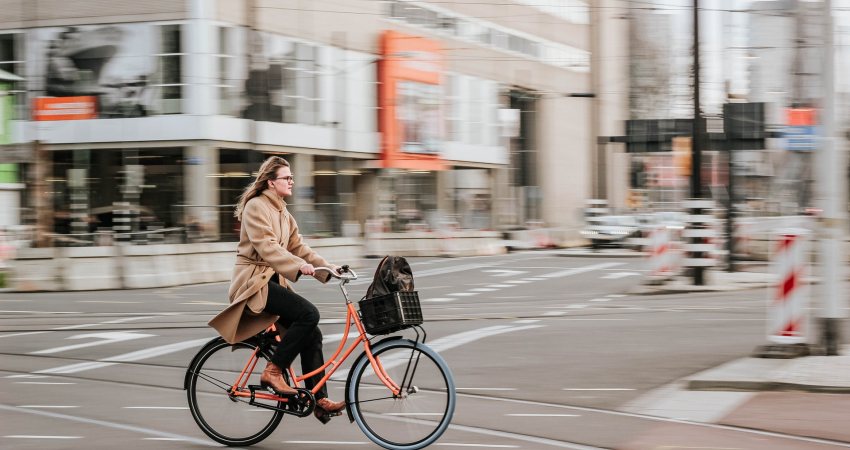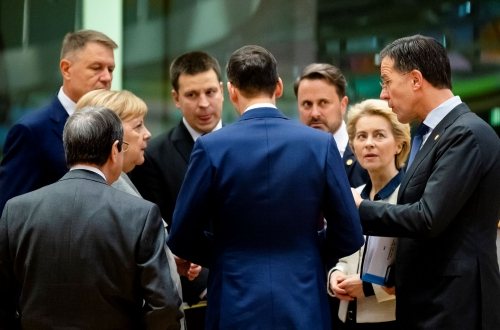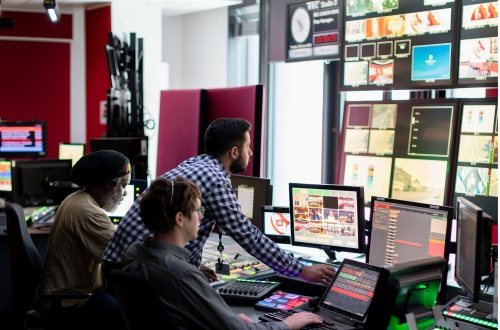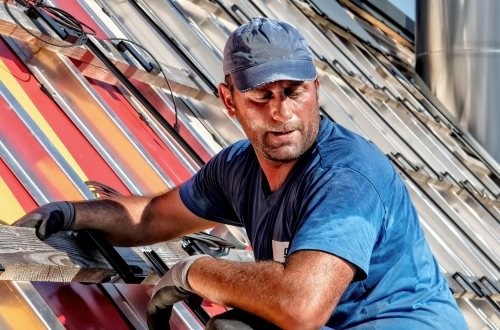The Green Deal: great ambition without major transition
Picture by Visual Stories || Micheile via Unsplash

This summer, the European Commission presented their plans for the Grean Deal. The plans are ambitious, but focus too much on technological transformation. This is what Tomas Vanheste states in his article about the European Fit-for-55 package.
In short:
- The European Commission presents ambitious plans to reduce greenhouse gas emissions to net zero by 2050.
- They focus mainly on technological transformation and pay little attention to society's support for and acceptance of the objectives.
- Europe needs to focus more on system change in areas such as transport and agriculture.
‘It will fundamentally change people's lives: from the supermarket to the workplace,’ that is what European Commissioner Frans Timmermans said in an interview about the plans for the realisation of the Green Deal he presented on 14 July 2021. The 'Fit for 55' package, which the European Commission presented that day, aims to reduce greenhouse gas emissions by 55% below 1990 levels by 2030 and to reach net zero by 2050.
In addition, in the overarching communication about all legislative proposals, the committee emphasises that their plans will bring about a transformation that will change our entire economy and society. We will grow and eat food differently, live and work differently, and travel and relax differently.
That is exactly how the European Commission's plans were received: as a bold, ambitious and radical attempt to cut greenhouse gas emissions. And as if to underline the need, very extreme rainfall in the week of the launch led to dramatic floods resulting in deaths and huge material damage in the Ardennes and the Eiffel.
‘We have been warning people about this type of catastrophe for 30 years already,' said Jean-Pascal Van Ypersele, former chairman of the UN climate panel. He concluded with the sombre message that even the most ambitious climate plan is not enough to match the urgency of the problem. And although he thinks that the proposals in the European Green Deal are going in the right direction, he is concerned that they are only proposals. He fears that it will take years to turn them into laws and that they will eventually emerge in a watered-down form.
It is only too true: in the years to come, the proposals will be the subject of fierce debate among the EU Member States and there is a good chance that the need to compromise will weaken them. But the negotiation period that follows will also be an opportunity to take a critical look at the plans and see where improvements are needed.
Focus on technological transformation instead of societal transition
The European Commission is strongly committed to the electrification of the car market. By 2030, the emissions of all European cars must be reduced by 55%. From 2035, all new cars must be emission-free. De facto, this means that the combustion engine has to step aside and the electric engine has to take its place.
The committee proposes the substitution of one dirty technology for another clean one. But meanwhile we continue along the same path. For example, the set of measures contains no plan for a modal shift, for a shift from the car to other forms of transport such as the bicycle. The European cycling organisations were therefore disappointed. They called 'Fit for 55' a 'missed opportunity'.
Nor does the package contain a plan for strengthening public transport. Yet the CER, the voice of the European railway companies, is delighted. This is because the European Commission wants to introduce a system of emissions trading for transport and the urban environment. By decreasing the number of emission rights for fuel suppliers to these sectors annually, the commission hopes to drive up the CO2 price. And that ever-increasing financial incentive should ensure that emissions fall steadily. The railway sector, meanwhile, expects the rising CO2 price to contribute to a switch to rail transport, as transport by rail causes far fewer CO2 emissions.
Green technology also has its downsides
This financial incentive is definitely a gain. The question is whether more incentive is needed. At a press conference in early July 2021, Frans Timmermans himself said that European public transport is in trouble and that we need a dynamic and efficient public transport. However, two weeks later, when Timmermans and his colleagues presented the plans, there was no mention of concrete plans for public transport. Nor does the committee give any thought to whether mobility should perhaps be reduced, for example by intervening in spatial planning and bringing living and working closer together.
The European Commission is putting its faith in the transition to electric mobility. It recognises that the acceleration of electrification will lead to a strong growth in demand for batteries and the materials they require, and foresees increasing pressure on the supply of raw materials such as lithium, cobalt and graphite in particular. To this end, the EU wants to increase the extraction of these materials from its own soil. For example, in the village of Cañaveral in south-west Spain. The plans to open a lithium mine there have divided the village. Some see it as an opportunity to breathe new life into the languishing community. Others fear it will destroy the natural environment.
Green technology has its own downsides and dilemmas. If technology research in the past decades has shown anything, it is that new technologies can simultaneously be an opportunity for some and a threat to others. As the Rathenau Instituut showed in its publication 'From technological dreams to societal action', the view that technology comes down from heaven like manna to bring salvation to people is an illusion. Technological and social innovation go hand in hand and are accompanied by ups and downs. The results are often different for different parties and are often difficult to foresee. Just think of the gas extraction in Groningen, where the downsides only came to light decades later. The European Commission sees electric cars too much as a miracle solution.
The dream of sustainable aviation
The same applies to the plans for sustainable aviation. The European Commission opens the document ReFuelEU Aviation with and ode to flying. It sees aviation as a driver of social and regional cohesion that creates jobs, allows business to flourish and stimulates tourism. Although including aviation in the Emissions Trading System will lead to rising ticket prices, the commission still foresees a 77% growth in air traffic by 2050 compared to 2015.
The EU's proposed solution is not to reduce air traffic - not even within Europe - but to make it cleaner. The miracle solution to achieve this is Sustainable Aviation Fuel (SAF). In this case, the committee does not want to ban the combustion engine. The sustainable fuel must be usable in the engines of current aircraft. Its share must increase from 5% in 2030 to 63% in 2050.
Please note that this aviation fuel, classified as sustainable, is by no means emission-free. The European Commission writes that biofuels from food crops are essential, as this is currently the most commercially mature technology available. However, biofuels from food crops are also very controversial, because they can eat up valuable agricultural land and possibly lead to deforestation. Also, the actual reduction in CO2 emissions often does not meet the standards set by the European Union itself. Furthermore, biofuels also cause the emission of nitrogen oxides and particulate matter.
If we combine the fact that even in the dream scenario, such renewable fuels account for only 63%, with the foreseen growth of aviation, we see that this sector will remain a solid source of greenhouse gas emissions. The carbon-neutral economy envisaged by the EU can therefore only be achieved by creating negative emissions elsewhere, for example through CO2 storage or the large-scale planting of forests, two expensive solutions that have so far proved very difficult to achieve in practice.
No measures concerning agriculture
‘To really bring down emissions in the coming years, three sectors are crucial: housing, transport and agriculture,' Frans Timmermans said in the interview quoted in the opening sentences of this article. For housing and transport, an emissions trading system should do the trick. And for agriculture? The measures proposed on 14 July do not cover that, because 'we've only just reached agreement on that,' the European Commissioner said.
He was referring to the agreement reached at the end of June between the European Parliament, the European Commission and the member states on the Common Agricultural Policy (CAP) for the period up to 2027, still the largest item in the European budget. But how this agreement is supposed to contribute to a sharp reduction in greenhouse gas emissions from agriculture is a mystery. In essence, the structure of European agricultural policy remains the same: farmers receive income support related to the amount of land they own. Only a quarter of that money is available for farmers who make special efforts for the environment and climate. The payment of the rest of the money is linked to requirements that farmers keep their land in 'Good Agricultural and Environmental Condition'. These include mandatory crop rotation, the prohibition to cut hedges during the breeding season and the construction of buffer strips along watercourses. But these basic conditions are hardly any stronger than in the previous CAP, which the European Court of Auditors judged had not contributed to making agriculture more environmentally friendly.
Scientists such as Guy Pe'er of the German Centre for Integrative Biodiversity Research in Leipzig therefore reacted critically. 'The main lesson I learn from the CAP reform is that science really doesn't matter if the processes are not designed to accommodate it,' he wrote on Twitter. Pe'er was the first author of a piece in Science proposing a route to a greener CAP. One of the recommendations: make the opaque policy process more transparent and ensure public participation and co-creation by scientists, environmental groups and citizens.
In a manifesto signed by 3,600 scientists, Pe'er and colleagues already called for CAP reform in March 2020. The first of their ten proposals: change direct payments based on land area to payments for the provision of public services. This recommendation can also be found in the report on the future of agriculture that Angela Merkel received in early July 2021. Direct payments should be converted to a system in which farmers receive money for providing social services, such as landscape management and combating climate change, according to the advisory board set up by the German government.
Involve citizens in the process of transitioning to a carbon-neutral economy
To really make the Green Deal work, the European Commission will have to be more radical in its thinking. Instead of turning a few knobs on the stagnant and environmentally ineffective agricultural policy, the Commission will have to initiate a real systemic change. And in order to get the right ideas and the right support, it would be wise to give scientists and environmentalists, farmers and citizens the opportunity to participate fully in the process.
In other areas crucial to the realisation of the Green Deal - energy management and transport - Europe will also have to give up on the idea of getting there simply by replacing dirty technologies with clean ones. On the bumpy transition path ahead, technological choices will have varying effects on different groups in society. It is therefore of the utmost importance to involve citizens in the process of transitioning to a carbon-neutral economy. The Social Climate Fund - proposed by the European Commission to mitigate the negative effects on vulnerable groups - is a first step, but not enough by far.
This article was written at the request of the Rathenau Instituut by Tomas Vanheste, who regularly reports on European developments. Vanheste (1968) studied Philosophy of Science, Technology and Society at the University of Twente, where he also obtained his PhD. He worked for Vrij Nederland and De Correspondent and now writes as an independent journalist for De Groene Amsterdammer, among others.




